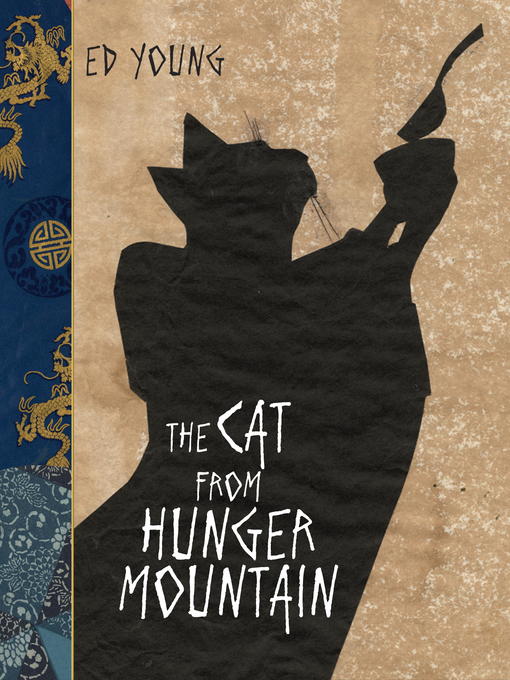
The Cat From Hunger Mountain
فرمت کتاب
ebook
تاریخ انتشار
2016
Lexile Score
870
Reading Level
2-5
ATOS
3.6
Interest Level
K-3(LG)
نویسنده
Ed Youngشابک
9780698182691
کتاب های مرتبط
- اطلاعات
- نقد و بررسی
- دیدگاه کاربران
نقد و بررسی

Starred review from October 3, 2016
Young (Should You Be a River) weaves an elegant cautionary fable about Lord Cat, who lives “high above everyone” in a lofty pagoda. Young’s evocative, abstract paper collages convey the vulgar opulence—and later the terrifying scarcity—of Lord Cat’s existence. He hires a peacock to tailor a cream-colored kimono, sends birds of prey to bring him game animals, and has a panda wash his rice in the river and prepare his meals (“Can’t you see that the bowl is half-empty? Take it away,” Lord Cat commands). He lives as though material supplies are infinite, but a persistent drought brings an end to his prosperity. Downriver from Hunger Mountain, Lord Cat hears of “a kind monk in a modest temple nearby who gave free food to the hungry” and discovers what became of all the rice he threw away. Young crafts his images from a variety of patterned papers and photographs, a repurposing that gracefully echoes the story’s themes. Tellingly, he dedicates this elegant story to “the strange virtue in deprivation,” foreshadowing Lord Cat’s revelation while inviting interpretation and conversation. Ages 4–8. Agent: Christa Heschke, McIntosh & Otis.

A wealthy lord has everything, yet it's never enough until deprivation teaches him life's true riches.Lying in luxury atop Hunger Mountain, a haughty cat lord lives in excess. His clothes are spun from silk and gold, and he always leaves his bowl of the finest rice half eaten. But a drought begins, and famine spreads. The villagers leave; still the arrogant feline stays, refusing to part with his possessions. Finally, starving and alone, the lord ventures out and must beg for food. When a kindly monk gives him a spoonful of rice--the grains of which were collected from the cat's wasted extravagance at Hunger Mountain--the lord finally understands what it means to be blessed. The well-paced fable is visually stunning, as photographs, textured paper, string, and other materials combine into magnificent paper collage illustrations. At times abstract but always beautifully composed, the artwork shows a deep appreciation for its audience, boldly challenging readers to interpret and extract meaning. During the cat's epiphany, the mountain and mist resolve into a symbolic panda servant dutifully washing the rich lord's rice. In a time when almost all illustrators use digital manipulation, this artist only needs paper and scissors to assemble a brilliant image. Young is at the height of his powers in this fable that offers a feast for the eyes, mind, and soul. A visual masterpiece. (Picture book. 4-8) COPYRIGHT(1) Kirkus Reviews, ALL RIGHTS RESERVED.

Starred review from October 1, 2016
K-Gr 4-Lord Cat lives well on his mountaintop, blessed with the finest of goods and plenty of rice to eat. He has servants to build him the best home and prepare and serve his delicious meals. There are also workers to tend his prolific rice paddies. Life is stable until, one year, drought hits and crops fail. Eventually most of the villagers move from the mountain in search of a better life. Lord Cat refuses to abandon all that he has accrued even though his great wealth now means nothing. Finally, at the point of starvation, he leaves his home to beg for food from whomever he can. He learns of a generous monk, willing to serve rice to any in need. Lord Cat becomes most grateful for just a half bowl of rice that he would have scorned and thrown away before. Lord Cat learns an invaluable lesson when he discovers how the gracious monk accumulated his reserve. Caldecott-winning author/illustrator Young has created another stunning and meaningful picture book to be enjoyed by all ages. This poignant story reinforces the importance of limiting waste, being grateful for what one has, and sharing in a manner that is deliberate and sincere. The animal characters make this title especially inviting and accessible for young readers. The visuals, completed in mixed-media collage, are striking with their use of many colors, textures, and types of materials. This book is exquisite in text, tone, and illustration. VERDICT A compelling fable that is crucial for humanity and will spark meaningful classroom conversations.-Amy Shepherd, St. Anne's Episcopal School, Middleton, DE
Copyright 2016 School Library Journal, LLC Used with permission.

November 1, 2016
Grades 1-3 Lord Cat lives in a tall pagoda atop Hunger Mountain and looks down on his fields below, yet he is never satisfied. Dressed in fine garments, he eats half the rice in his enormous bowl and discards the rest. When drought destroys the crops, his servants and the farmers go hungry and move away. Humbled, the cat becomes a beggar and makes his way to a monk who feeds the poor. Where did the fine rice come from? For years, the monk collected the grains that the wealthy cat and his harried servants wasted. Now he shares them with all. The cat feels blessed. Written with simplicity and dignity, Young's original fable has no stated moral, but it could open up several topics for discussion. The striking illustrations are complex collages combining textured, woven, and marbled papers with partial photos of subjects such as animals, mountains, trees, wooden shutters, and carpeting. Most effective when viewed from a little distance, they create a series of varied, evocative scenes. A handsome picture book.(Reprinted with permission of Booklist, copyright 2016, American Library Association.)

























دیدگاه کاربران